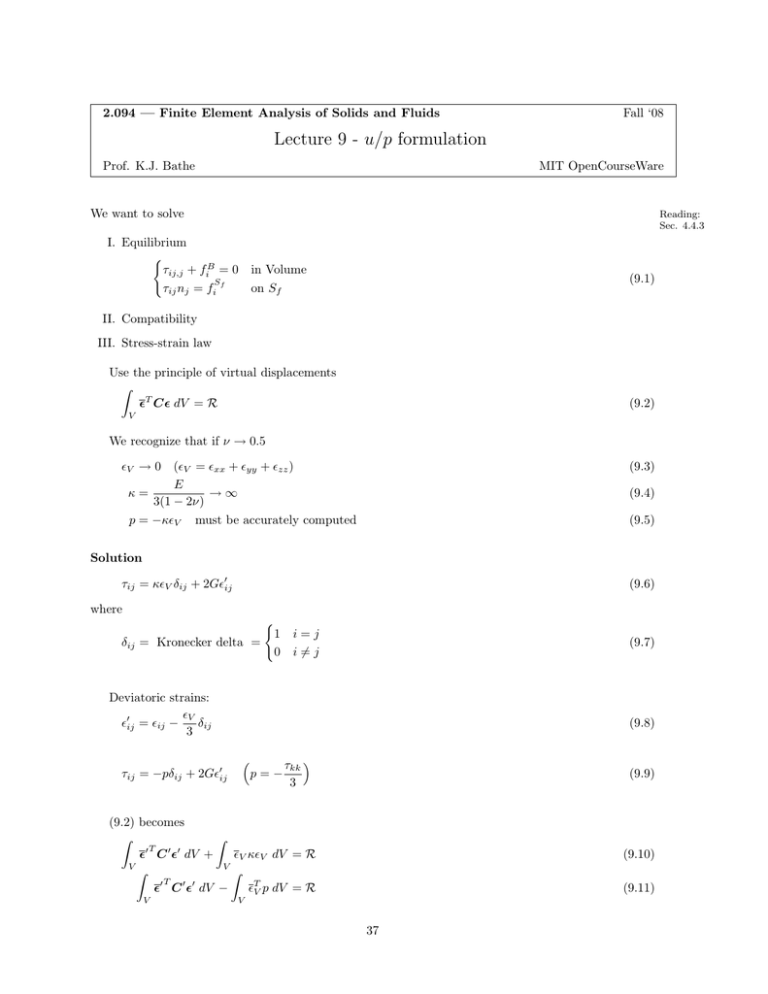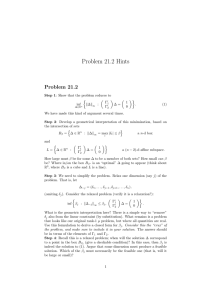Lecture 9 - u/p formulation
advertisement

2.094 — Finite Element Analysis of Solids and Fluids
Fall ‘08
Lecture 9 - u/p formulation
Prof. K.J. Bathe
MIT OpenCourseWare
We want to solve
Reading:
Sec. 4.4.3
I. Equilibrium
�
τij,j + fiB = 0 in Volume
S
τij nj = fi f
on Sf
(9.1)
II. Compatibility
III. Stress-strain law
Use the principle of virtual displacements
�
�T C� dV = R
(9.2)
V
We recognize that if ν → 0.5
�V → 0
(�V = �xx + �yy + �zz )
E
→∞
κ=
3(1 − 2ν)
p = −κ�V must be accurately computed
(9.3)
(9.4)
(9.5)
Solution
τij = κ�V δij + 2G��ij
(9.6)
where
�
1
δij = Kronecker delta =
0
i=j
i=
� j
(9.7)
Deviatoric strains:
�V
��ij = �ij −
δij
3
τij = −pδij + 2G��ij
(9.8)
�
p=−
τkk �
3
(9.9)
(9.2) becomes
�
�
�T � �
� C � dV +
�V κ�V dV = R
V
V
�
�
T
�� C � �� dV −
�TV p dV = R
V
(9.10)
(9.11)
V
37
MIT 2.094
9. u/p formulation
We need another equation because we now have another unknown p.
p + κ�V = 0
(9.12)
p (p + κ�V ) dV = 0
�V �
p�
−
p �V +
dV = 0
κ
V
(9.13)
�
(9.14)
For an element,
u = Hû
(9.15)
�
� = BD û
�V = BV û
p = Hp p̂
(9.16)
(9.17)
(9.18)
Plane strain (�zz = 0)
4/1 element
Example
�V = �xx + �yy
⎡
�xx − 31 (�xx + �yy )
⎢ �yy − 1 (�xx + �yy )
3
�� = ⎢
⎣
γxy
− 13 (�xx + �yy )
Reading:
Ex. 4.32 in
the text
(9.19)
⎤
⎥
⎥
⎦
(9.20)
� 0!
Note: �zz = 0 but ��zz =
p = Hp p̂ = [1]{p0 }
(9.21)
p(x, y) = p0
(9.22)
We obtain from (9.11) and (9.14)
�
��
� �
�
Kuu Kup
û
R
=
Kpu Kpp
p̂
0
(9.23)
�
T
�
BD
C BD dV
V
�
=−
BVT Hp dV
V
�
=−
HpT BV dV
V
�
1
=−
HpT Hp dV
κ
V
Kuu =
(9.24a)
Kup
(9.24b)
Kpu
Kpp
(9.24c)
(9.24d)
38
MIT 2.094
9. u/p formulation
In practice, we use elements that use pressure interpolations per element, not continuous between
elements. For example:
Then, unless ν = 0.5 (where Kpp = 0), we can use static condensation on the pressure dof’s.
Use p̂ equations to eliminate p̂ from the û equations.
�
�
−1
Kuu − Kup Kpp
Kpu û = R
(9.25)
(In practice, ν can be 0.499999. . . )
The “best element” is the 9/3 element. (9 nodes for displacement and 3 pressure dof’s).
p(x, y) = p0 + p1 x + p2 y
(9.26)
The inf-sup condition
Reading:
Sec. 4.5
⎡
⎤
=�V
� �� �
�
⎢
⎥
⎢ Vol qh � · vh dVol ⎥
inf
sup
⎢
⎥≥β>0
���� ���� ⎣
�qh � �vh �
⎦
� �� �
qh ∈Qh vh ∈Vh
(9.27)
for normalization
Qh : pressure space.
If “this” holds, the element is optimal for the displacement assumption used (ellipticity must also be
satisfied).
Note:
infimum = largest lower bound
supremum = least upper bound
For example,
inf {1, 2, 4} = 1
sup {1, 2, 4} = 4
inf {x ∈ R; 0 < x < 2} = 0
sup {x ∈ R; 0 < x < 2} = 2
(9.23) rewritten (κ = ∞, full incompressibility). Diagonalize using eigenvalues/eigenvectors.
For a mesh of element size h we want βh > 0 as we refine the mesh, h → 0
39
MIT 2.094
9. u/p formulation
For
(entry [3,1] in matrix) assume the circled entry is the minimum (inf) of
.
Also, all entries in the matrix not shown are zero.
Case 1 βh = 0
⎧
0 · uh |i = 0 (from the bottom equation)
⎨
⇒
α
·
u
|
+
0
· ph |j = Rh |i (from the top equation)
⎩ ���� h i
�
=0
⇒ no equation for ph |j
⇒ spurious pressure! (any pressure satisfies equation)
Case 2 βh = small = �
� · uh |i = 0
∴�·
⇒ uh |i = 0
ph |j + uh |i · α = Rh |i
Rh |i
⇒ ph |j =
�
�
⇒
displ. =
pressure →
0
large
�
as � is small
The behavior of given mesh when bulk modulus increases: locking, large pressures. See Example
4.39 textbook.
40
MIT OpenCourseWare
http://ocw.mit.edu
2.094 Finite Element Analysis of Solids and Fluids II
Spring 2011
For information about citing these materials or our Terms of Use, visit: http://ocw.mit.edu/terms.


